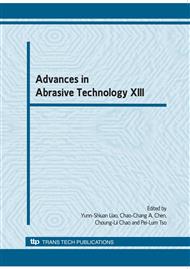p.119
p.125
p.127
p.133
p.139
p.143
p.148
p.154
p.159
Ultrasonic Vibration Grinding Test of Composite Ceramics Based on the Nonlocal Theory
Abstract:
The effects of ultrasonic frequency on the grinding force and surface quality were analyzed from the grinding experiment on ZTA nano-composite ceramics. The results indicate that, in the same parameters, ultrasonic normal grinding force is about 65 to 85 percents of the ordinary grinding condition, and the surface quality is better than that of ordinary grinding condition, as the frequency increasing, this trend will be more evident. The reasons for it were also discussed from microscopic and the nonlocal theory in this paper.
Info:
Periodical:
Pages:
139-142
Citation:
Online since:
August 2010
Authors:
Price:
Сopyright:
© 2010 Trans Tech Publications Ltd. All Rights Reserved
Share:
Citation:


